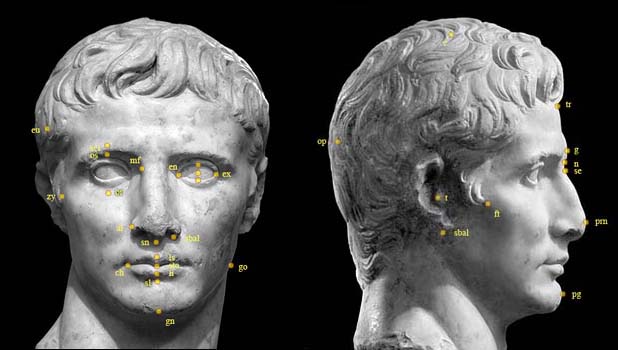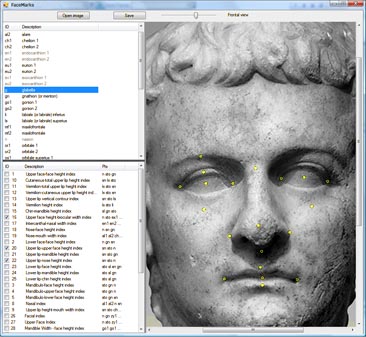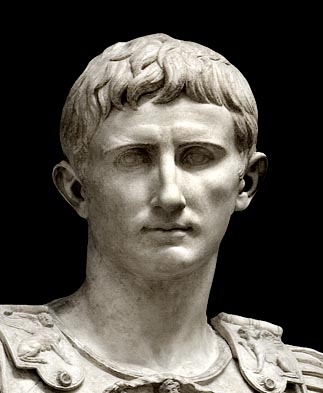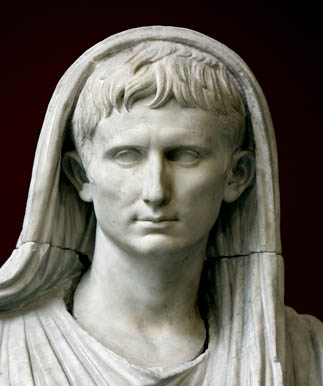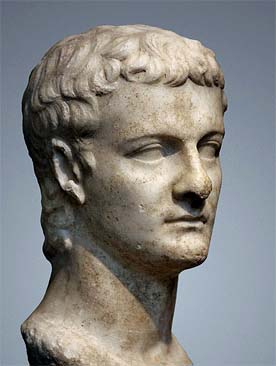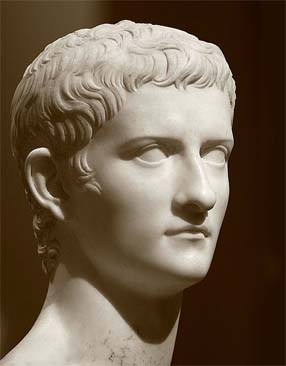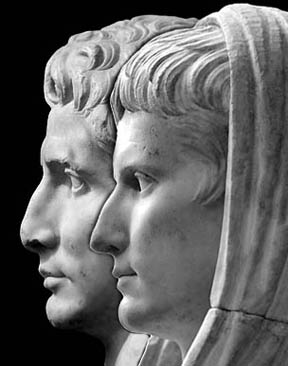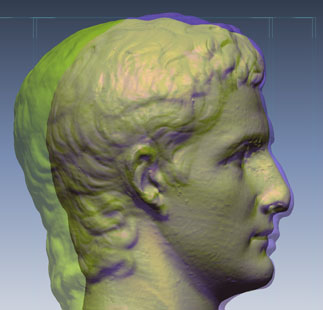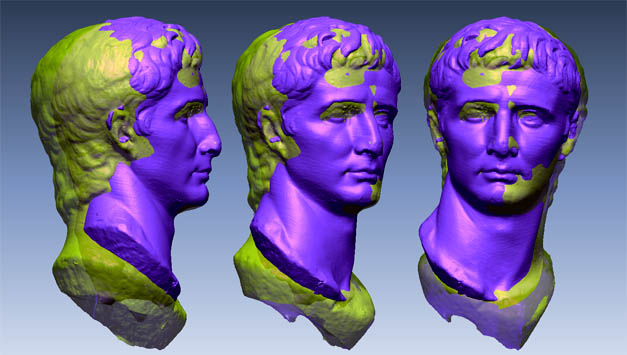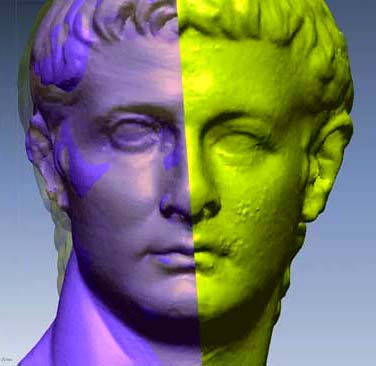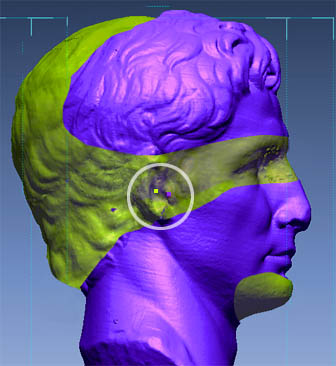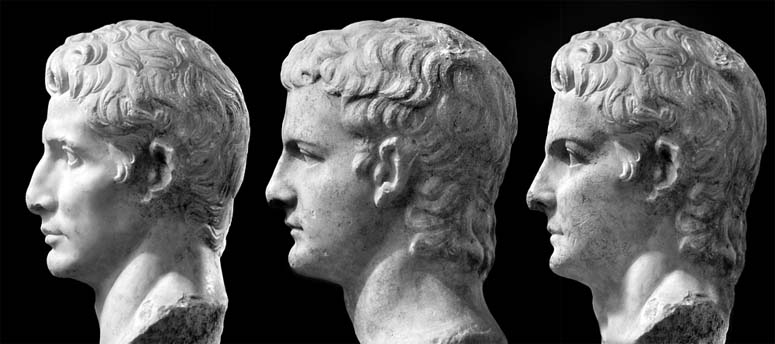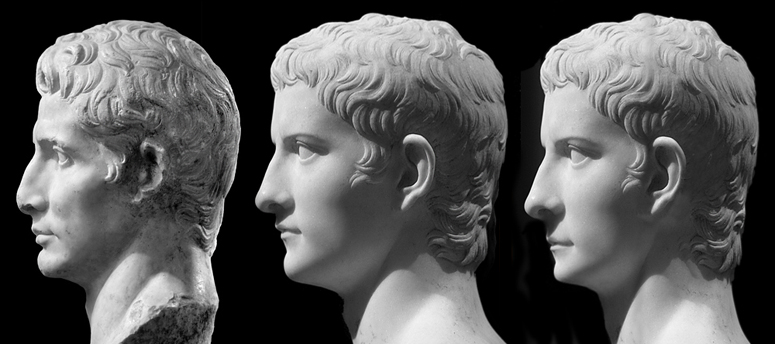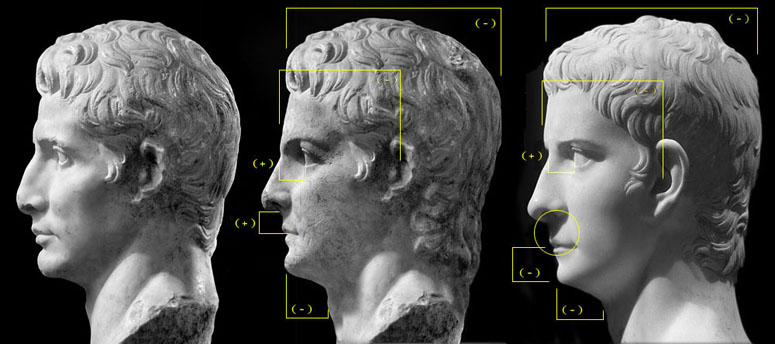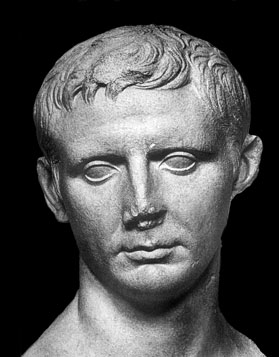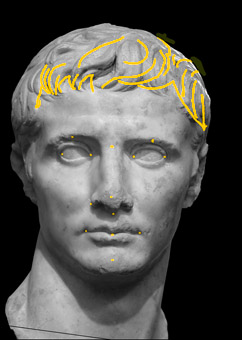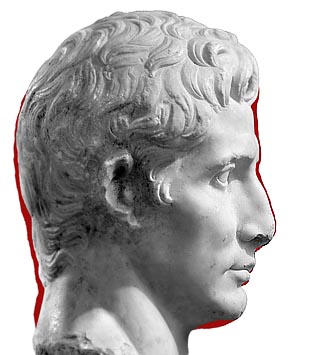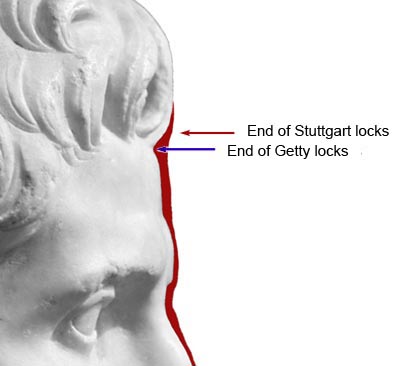Rome101.com home Up to Imperial Portraiture
We recently made a detailed study of the anthropometric aspects of this and many other portraits of Augustus and Caligula. From this work we can show with great confidence that earlier thoughts on the origin of the Getty Augustus are incorrect. The portrait, although indeed reworked, never portrayed Caligula. Scholars including Klaus Vierneisel, Paul Zanker, Hans Jucker and Jiri Frel have given evidence for the reworking of Caligula's features into those of Augustus that we now see on this marble portrait. Eric Varner (2001) provides a good summary of this evidence, including the following points:
We confirmed some of the characteristics seen as evidence of recarving from a portrait of Caligula (discussed in detail below), such as removal of locks on the nape of the neck, reworked locks and forehead alterations. But, as we will show, these conditions are not the result of recarving of a Caligula portrait. Other features observed by these scholars, such as the perceived reshaping of the mouth and Caligula's wider eyes, can best be explained as mere illusions, because measurement and statistical analysis of various portraits of these rulers does not find these conditions, accepted as they are, to exist at all. We used both basic photogrammetry and laser scanning to analyze ancient imperial portraits. We shot photos of sufficient detail, with appropriate photographic technique (e.g. that used to make measurements for craniofacial plastic surgery, including image sharpness, facial plane alignment and large subject-to-camera distance compared to head height), to accurately identify facial landmarks and measure distances between them in the frontal and profile planes. For the Getty Augustus, the Getty Caligula, and a few other portraits, we also used a Polhemus Scorpion scanner to digitize the portraits, and then used Rapidform, Inc's XOR reverse engineering software to clean up the data and to manipulate the 3-D models. The resulting data allowed us to characterize and compare these portraits objectively and accurately. Because ancient portraits are found in various sizes, we used facial proportions, rather than absolute distances or sizes, to characterize the portraits. Facial proportions are the basis for anthropometric analyses of human heads used in aesthetic and reconstructive surgery. To compare a series of different Augustus and Caligula portraits we initially used fifty eight of the proportion indices identified by craniofacial surgeons Farkas and Munro (1986, 1984; also Powell and Humphries, 1984) in their work on proportions of the human head. We selected these for their ability to be located in photographs of frontal and profile views of the sculptures taken specifically for this purpose (fig. 2a and 2b). A few of these proportions still required approximations because of the presence of hair or because they involved landmarks that on a human head would be better located by palpation. Our sample of portraits included some sculptures with restored noses, in cases where enough of the original nose was present to reasonably estimate vertical position of the pronasale and where enough original marble existed to establish nasofrontal and nasolabial angles (see Table 1 for a guide to facial landmark names). Most proportions involving ears were initially excluded, since few ancient sculptures retain original ears.
To determine the facial proportions from our photos we wrote a computer program, which we called FaceMap (screen shot at right, fig. 3), that displays scalable frontal and profile photographs on screen and allows the user to identify the facial landmarks with mouse clicks. The program records the coordinates of the facial landmarks (listed in Table 1) in a relational database, from which facial proportions and statistical calculations are made and reported. This approach eliminates the very tedious and error-prone job of manually measuring distances, and calculating ratios, averages and standard deviations. Our initial 2-D analysis of about 25 Julio-Claudian portraits using FaceMap yielded only a few statistically significant differences between portraits of Caligula and portraits of Augustus not thought to be recarved from portraits of other rulers. When we superimposed 3-D models of the Getty Augustus and the Getty Caligula, we saw major anthropometric differences, however. On this basis we selected a different set of craniofacial proportions and analyzed the profile and frontal-view photos, seeing statistically significant differences between the Augustus and Caligula data (i.e., the difference between mean values of a given facial proportion for Augustus and Caligula is large compared to the standard deviations of that proportion for the group of specimens of either subject). For example, all nine primary portraits of Augustus we surveyed have lower face regions that are very similar to those of the Caligula portraits; but the Augustus portraits have taller upper faces (this is explained with greater anthropometric precision below). This fact is immediately apparent when 3-D models or photographs are superimposed and scaled so that the skulls are nominally the same size. Also, when superimposed in this way, Caligula's ear to nose bridge distance, as seen in profile, is always markedly greater than that of Augustus. Armed with accurate measurements of the Getty Caligula and Getty Augustus, statistical data on the same measurements for populations of Caligula and Augustus portraits, and 3-D models of several portraits including a Caligula and the Getty Augustus, we can investigate the origin of the Getty Augustus far more objectively than has been previously possible. We'll look, point by point, at the evidence summarized by Varner. 1. Caligula's receding lower lip. This claim suffers from potential ambiguity over what exactly a receding lower lip means. Caligula's upper and lower lip are usually rendered smaller than those of Augustus. The term, "receding," suggests that Caligula's lower lip projects less than that of the average face. This is true, but it is often more true of Augustus than of Caligula. All specimens of the Prima Porta type Augustus show this condition more than do the Getty Caligula or either of the Caligula portraits at the Ny Carlsberg Museum in Copenhagen. The Caligula portrait at the New York Met Museum displays roughly the same lower lip projection as that of the Getty Augustus. In any case, this point can be ruled out as evidence that the Getty Augustus was recarved from a Caligula portrait on the basis that the premise itself is invalid. 2. Chin made more square. This point is related to the observation
made by various scholars that Caligula has a weak chin, which would need
to be altered to reflect Augustus's stronger chin. As with the previous
point, this one can be dismissed on the grounds that statistical data
does not support the premise in the first place. Some scholars observe
that this weak chin was inherited from Livia and therefore would not be
seen in Augustus. Our measurements indicate that this notion, which
indeed subjectively appears to be valid, is in fact incorrect any way
you measure it. Also of interest, we found that while the Getty chin is almost identical to that of other Prima Porta type Augustus portraits, the lips of the Getty head are actually somewhat fuller than those of the other Prima Porta type specimens.
3. Removal of Caligula's longer locks around the neck (cropping his "shag" haircut). Craniofacial measurements are not relevant to this claim. Close inspection of the Getty head confirms the marks that likely indicate removal of the longer locks. This would be necessary if a Caligula head were recarved into one of Augustus, but it is not sufficient evidence to conclude this origin, because it could also indicate recarving of another subject, as will be shown below. 4. Hole in the forehead. This is indeed evidence of recarving. Since the sculptor could not add material to the primary portrait, rendering Augustus's distinctive deep hair pincers (above right eye, figs. 4 and 5), a feature of the Prima Porta portrait type, required some creativity - in this case carving the cleft between the pincers deeper than the projected surface of the scalp. Again, this is evidence of recarving, but it does not point to Caligula at all; using any other primary portrait would require similar measures. 5. Caligula's wide eyes and hollow (concave) temples retained. This indicates that the eyes and temples of the hypothesized primary portrait would have been retained in the secondary portrait. Both of these characteristics are easy to measure in frontal-view photos. Eye separation and intercanthal widths are roughly equal in the portraits of Augustus and Caligula. The standard deviations of the measurements between specimens of each subject are large compared to the mean differences between subjects, i.e., no conclusion can be drawn about relative eye spacing of portraits of Augustus and Caligula. The hollow-temple condition is present in most portraits of both rulers and some portraits of Germanicus and Claudius. However, it is present to a greater degree in most specimens of all types (as delineated by Boschung or Pollini) of Augustus portraits than it is in most specimens of Caligula. For example, it is present in the Via Labicana (Augustus as Pontifex Maximus) and Getty portraits more so than in the Met or Getty Caligula portraits. As with 1 and 2 above, it appears that perceptions of what the human Caligula might have looked like, perhaps colored by ancient physiognomical character judgments, may have influenced scholars' assessments of what reshaping Caligula into Augustus would entail. Anthropometric analysis assures us, however, that no particular problems would be imposed on a sculptor who needed to eliminate Caligula's hollow-temple condition in order to transform it into Augustus, because, relative to Augustus, no such condition existed in the first place.
Thus far we've described findings from our initial craniofacial investigation of portraits of Augustus and Caligula, modifications to that analytical approach provided by viewing 3-D models, and rejection of some of the premises for scholars' conclusions that the Getty Augustus was recarved from a portrait of Caligula. We've also confirmed other observations of these scholars that evidence of recarving is present on the Getty Augustus. We'll now discuss other aspects of the 3-D models and address the matter of what might have been the original portrait from which the Getty was recarved. Having 3-D computer models gives us a means of comparing marble portraits that was unavailable, if not unimaginable, a short time ago. The software we selected for this task, Rapidform XOR, allows us to superimpose 3-D models of two portraits, and to translate, rotate and scale them independently, while viewing them as solid surfaces or wireframes. When viewing as solid surfaces, we can vary the opacity of the portraits independently, thereby seeing the relative positions of each subject's facial landmarks. The ability to independently scale and translate the models with respect to each other allows us to attempt to match the surfaces of each portrait that were believed by scholars to be retained in the secondary portrait from the original surfaces of the primary portrait. In other words, an Augustus head could be recarved from one of Caligula by removing enough marble so that none of the original surfaces were retained. In this case the sculptor would have no constraints other than his artistic abilities; and the Caligula head would look like any other carved from a block of marble. For the evidence for recarving described above to work, however, many points or surfaces of the primary Caligula portrait would have to still be visible in the secondary, resultant Augustus. For example, the neck, some parts of the coiffure, a portion of the forehead, the eyes, the nasal root and the ears, for example, have to be those of the original Caligula head. 3-D models allow us to test the hypothesis of recarving using the surviving secondary Augustus portrait and an existing portrait of Caligula thought to be similar to the hypothetical primary portrait. On first look, placing the Getty Augustus inside (slightly smaller than) the Getty Augustus seems to work well (fig. 9); the profile contours appear to align well. However, in profile view, Augustus' eyes are far (about 6 mm when scaled to human size) behind those of Caligula. Since the hypotheses of recarving involve retention of the eyes from the primary portrait, we need to translate the Augustus head forward (to the right in fig. 9) to the point where the eyes align. Doing this pushes most of the surface of Augustus' face several millimeters beyond that of Caligula (fig. 10). Thus the sculptor would have needed to add material to the primary portrait in order to produce the secondary portrait. Superimposition of scaled profile photos of the Getty Augustus and the Met Caligula (fig. 7) yields the same result.
A similar problem is apparent in a frontal view of the 3-D models. We nominally aligned the two models for best fit of facial features and skull. Most features align well, but with a partially transparent Caligula head we noticed significant vertical misalignment of the eyes of the two subjects. Fig. 11 exhibits this condition well by showing the left half of Caligula's face as an opaque surface and the right half at reduced opacity (the brighter purple areas indicate slight protrusions of the Augustus facial surface through the Caligula surface, indicating very close alignment of the models). Augustus' right eye is several millimeters higher than that of Caligula. Again, superimposition of photos of this Augustus and other Caligula portraits show similar results. After seeing this difference in feature location in the 3-D models, we used our FaceMap program written for anthropometric calculations and found that the ratio of measurements Farkas identified as middle third face depth (vertical distance between tragion and subnasale) and lower face height (vertical distance between nasion and gnathion) is significantly greater in Augustus portraits than in Caligula portraits. In less clinical terms, Augustus's skull is very similar to Caligula's from chin to the nose, but his upper face is taller, resulting in higher eye sockets than Caligula. The superimposed 3-D models also showed that the horizontal distance from tragion to nasion (we used the tragion as a landmark instead of the auricular cavity because the scanner had difficulty seeing into the cavity) is greater on Caligula (fig. 12). Data derived from other portraits of the two rulers also showed statistically significant differences in this measurement compared to face height and width.
As a final means of investigating the hypothesis that the Getty Augustus was recarved from a Caligula portrait, we asked ourselves what a primary portrait of Caligula would have had to look like in order to yield the Getty Augustus, if certain features of the secondary portrait were preserved from those of the primary portrait. Those features include auricular cavities, eyes, orbital rims, neck at rear hair line, part of the forehead and some part of the mouth or chin, as the evidence the scholars saw for recarving requires these points to have retained. We used imaging software to warp photos of Caligula portraits in profile so that these features (those that would be preserved from the primary portrait) would still coincide with the same features on the existing Augustus head. In both cases the result is a head that does not look much like other portraits of Caligula; the distortions required to meet the conditions described above are quite severe. The Getty Caligula, for example (fig. 13), would require a large reduction of the head depth and a large reduction in the horizontal distance from the auricular cavity to the orbital rim for the hypothetical original Caligula to have been reworked into the current Augustus. Therefore a hypothetical primary Caligula would have had a greater distance from the auricular cavity to the orbital rim than that of the Getty Caligula. This hypothetical Caligula would also have had a greater distance from subnasale to stomion (essentially, bottom of nose to mouth) than that of the Getty Caligula. Its neck to chin (larynx - pogonion) distance would have been smaller than that of the Getty Caligula, because, as noted above, Caligula's chin is not weaker than that of Augustus. Stated differently, the chins of the existing portraits of Caligula have greater height and projection than those of a hypothetical Caligula head that could be recarved into the Getty Augustus. The distortions required for the Met Caligula to work as a hypothetical primary portrait from which the Getty was recarved are similar but even more severe (fig. 14). Key differences between the actual and hypothetical Getty and Caligula heads are summarized in fig. 15.
All of the preceding exploration of the hypothesis of recarving from Caligula points to the conclusion that it is incorrect. The Getty August clearly did not start out as a portrait of Caligula - at least no Caligula resembling any that exist today. Having dismissed Caligula as the source of the Getty head, we're still left with the issue that considerable recarving of some original did in fact occur, as evidenced by removal of locks at the back of the neck and considerable reworking of the forehead and front locks. Before we had scanned the portraits and developed the 3-D models, we presented our existing evidence against recarving to John Pollini, Professor of Classical Art and Archaeology at USC, an expert on Julio-Claudian portraiture who is particularly committed to interdisciplinary research. John agreed that based on the anthropometric analyses, Caligula could be eliminated. He immediately proposed a different primary portrait, which was in fact correct, although it took us several months to be sure. In the meantime, John assisted with scanning the portraits and participated in the remainder of the problem-solving process. Pollini's proposal for the primary portrait was what he has in previous work identified as a Type IV.A Augustan portrait, also known as the Stuttgart Type (fig 16). We superimposed profile view photos of the Stuttgart Augustus and the Getty Augustus, finding that the skull, facial features and auricular cavities aligned almost perfectly, except for the lower occipit, where it appears some hair has been removed on the Getty head. In frontal view, we saw virtually perfect alignment of the skull an facial features. The middle third face depth to lower face height ratio of the Stuttgart head, problematic in the Caligula portraits, is identical to that of the Getty Augustus, to the limits of measurability in photos. But one problem was apparent in frontal view - a few of the prominent locks near the center of the forehead of the Getty head are longer and extend somewhat farther down the forehead than the corresponding locks (fringe, bangs) of the Stuttgart head (fig 17). A sculptor recarving a primary portrait could not add marble to increase lock length in a secondary portrait. A closer look at the superimposed profiles puts the matter to rest. The recarved, recessed forehead, as noted by Zanker et al, is actually the consequence of a creative sculptor's solution to increasing the length of several locks from those of the Stuttgart type. He needed to lengthen the frontal locks, fortunately where their relief above the forehead was smallest, and to produce the characteristic hair pincers of the Prima Porta type. He solved the latter by carving a hair cleft that in a human would have penetrated the scalp - the best solution available since he couldn't add marble to thicken the hair in this region. He solved the former problem by carving away several millimeters of the forehead below the bottom of the to-be-lengthened locks, thereby increasing the relief available for the lengthened locks, the tips of which are retained marble from the forehead of the primary portrait (figs. 18, 19). Other types of earlier Augustus portraits, the Alcudia type in particular, are a good facial matches for the Getty head, but recarving the Alcudia type would not have required the drastic reworking of the locks. The Stuttgart type is the probable source, being both identical in facial proportions, and requiring the coiffure reworking that is indicated by evidence present on the Getty head.
Conclusion On the basis of anthropometric measurements and statistical analysis, we've shown it to be extremely unlikely that the Getty Augustus was recarved from an earlier portrait of Caligula; and we've shown it likely that it was recarved from a Stuttgart type Augustus portrait. Secondarily, we find that, despite the variability apparent in Julio-Claudian portraits of the same subject, ancient sculptors adhered strongly to the clay prototypes on which their marble carvings were based in certain of the facial proportions. Facial proportions, therefore, can aid in determining which of several imperial subjects a portrait was meant to portray; coiffure is no longer the sole basis for identifying the subjects of portraits. Collection of more data from secondary portraits and extant specimens of the likely primary portrait types from which they were derived will aid in investigating other recut portraits.
Watch a 10-minute video summary of this project. Acknowledgements We are indebted to Dr. John Pollini, Department of History and Department of Classics at USC for his participation in this project, sharing his deep knowledge of ancient portraiture, and mostly, his boundless energy and enthusiasm. We thank Karol Wight, Senior Curator of the Getty Villa, and Jerry Podany, Head of Museum Conservation, for allowing us to scan a number of portraits at the museum. Thanks also to Laure Marest-Caffey, who also assisted us in the galleries. We are grateful to Christopher Hallett, Associate Professor of Classics and Art History at UC Berkeley for sharing his ideas and experience in Roman portraiture. We thank Dan Ratta of Polhemus, who arranged for the loan of the Polhemus Scorpion scanner, upon which much of this project depended. Rapidform, Inc. lent us their amazing XOR reverse engineering software, which truly opened the door to a new dimension of portrait study. We thank Scott Anderson, Rob Liebert and Michael Tsang at Rapidform for their assistance and ideas on working with superimposed portrait models.
|
|
Table 1: Description of facial landmarks. |
||
| v | vertex | highest point of head |
| g | glabella | most prominent point between the eyebrows |
| op | opisthocranion | situated in the occipital region of the head is most distant from the glabella |
| eu | eurion | most prominent lateral point on each side of the skull in the area of the parietal and temporal bones |
| tr | trichion | point on the hairline in the midline of the forehead |
| zy | zygion | most lateral point of each of the zygomatic |
| go | gonion | most lateral point on the mandibural |
| sl | sublabiale | Determines the lower border of the lower lip or the upper border of the chin |
| pg | pogonion | most anterior midpoint of the chin, located on the skin surface in the front of the identical bony landmark of the mandible |
| gn | menton (or gnathion) | lowest median landmark on the lower border of the mandible |
| en | endocanthion | point at the inner commissure of the eye fissure |
| ex | exocanthion (or ectocanthion) | point at the outer commissure of the eye fissure |
| p | center point of pupil | Is determined when the head is in the rest position and the eye is looking straight forward |
| or | orbitale | lowest point on the lower margin of each orbit |
| ps | palpebrale superius | highest point in the midportion of the free margin of each upper eyelid |
| n | nasion | intersection of the frontal and two nasal bones |
| pi | palpebrale inferius | lowest point in the midportion of the free margin of each lower eyelid |
| os | orbitale superius | highest point on the lower border of the eyebrow |
| sci | superciliare | highest point on the upper border in the midportion of each eyebrow |
| se | sellion (or subnasion) | Is the deepest landmark located on the bottom of the nasofrontal angle |
| al | alare | most lateral point on each alar contour |
| prn | pronasale | most protruded point of the apex nasi |
| sn | subnasale | midpoint of the angle at the columella base where the lower border of the nasal septum and the surface of the upper lip meet |
| sbal | subalare | point at the lower limit of each alar base, where the alar base disappears into the skin of the upper lip |
| ac | alar curvature (alar crest) point | most lateral point in the curved base line of each ala |
| ls | labiale (or labrale) superius | midpoint of the upper vermillion line |
| li | labiale (or labrale) inferius | midpoint of the lower vermillion line |
| ch | cheilion | point located at each labial commissure |
| sto | stomion | Intersection of vertical facial midline and horizontal labial fissure between closed lips |
| sa | superaurale | highest point of the free margin of the auricle |
| sba | subaurale | lowest point of the free margin of the ear lobe |
| pa | postaurale | most posterior point on the free margin of the ear |
| obi | otobasion infrious | point of attachment of the ear lobe to the cheek |
| po | porion (soft) | highest point of the upper margin of the cutaneous auditory meatus |
| t | tragion | notch on the upper margin of the tragus |
|
Table 2. Common craniofacial
proportions in human anthropometry used in plastic surgery |
|||
| proportion index | proportion name | numerator | denominator |
| 2 | lower face-face height index | subnasale gnathion | nasion gnathion |
| 3 | mandibulo-face height index | stomion gnathion | nasion gnathion |
| 4 | mandibulo-upper face height index | stomion gnathion | nasion stomion |
| 5 | mandibulo-lower face height index | stomion gnathion | subnasale gnathion |
| 8 | nasal index | alare (r) alare(l) | nasion subnasale |
| 9 | upper lip height-mouth width index | subnasale stomion | chelion (r) chelion (l) |
| 10 | cutaneous-total upper lip height index | subnasale labiale superius | subnasale stomion |
| 11 | vermilion-total upper lip height index | labiale superius stomion | subnasale stomion |
| 12 | vermilion-cutaneous upper lip height index | labiale superius stomion | subnasale labiale superius |
| 14 | vermilion height index | labiale superius stomion | stomion labiale inferius |
| 15 | chin-mandible height index | sublabiale gnathion | stomion gnathion |
| 19 | nose-mouth width index | alare (r) alare (l) | chelion (r) chelion (l) |
| 23 | lower lip-face height index | stomion sublabiale | subnasale gnathion |
| 25 | lower lip-chin height index | stomion sublabiale | sublabiale gnathion |
| 28 | mandible Width - face height index | stomion gnathion | nasion gnathion |
| 29 | mandibular index | stomion gnathion | gonion (r) gonion (l) |
| 30 | Face height index | nasion gnathion | trichion gnathion |
| 32 | mandible width - total face height index | gonion (r) gonion (l) | trichion gnathion |
| 35 | eye fissure index | palpebrale superius palpebrale inferius | exocanthion - endocanthion |
| 52 | intercanthal - skull base width index | endocanthion (r) endocanthion (l) | tragion (r) tragion (l) |
| 54 | intercanthal - nasal width index | endocanthion (r) endocanthion (l) | alare (r) alare (l) |
Leslie G. Farkas and Ian R. Munro. Anthropometric Facial Proportions in Medicine, 1986. ISBN-13: 978-0398052614.
Leslie G., Farkas M.D. Anthropometry of the Head and Face by. Lippincott, Williams & Wilkins; 2nd edition (January 15, 1994). ISBN-10: 0781701597. ISBN-13: 978-0781701594.
Powell, Nelson and Brian Humphries. Proportions of the Aesthetic Face (The American Academy of Facial Plastic and Reconstructive Surgery) by Thieme Medical Pub (March 1984), ISBN-10: 0865771170. ISBN-13: 978-0865771178.
Eric R Varner. From Caligula to Constantine: Tyranny & Transformation in Roman Portraiture, 2001. ISBN-13: 978-1928917014. p 122.
© Copyright 2009, 2012 William Storage. All rights reserved.

